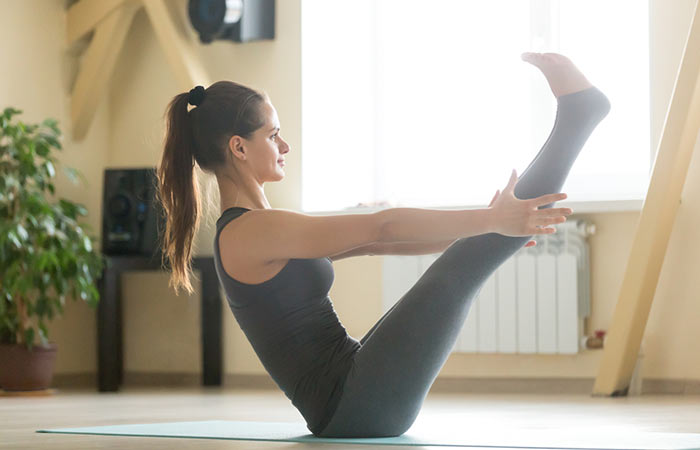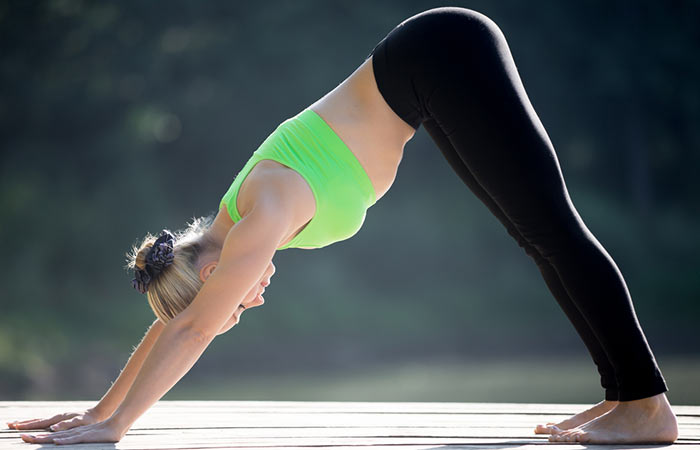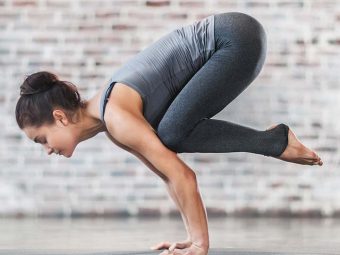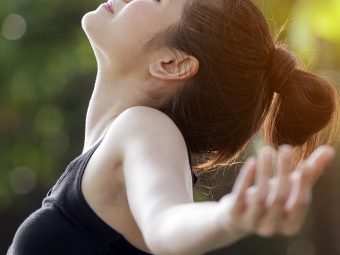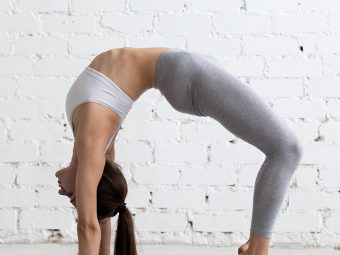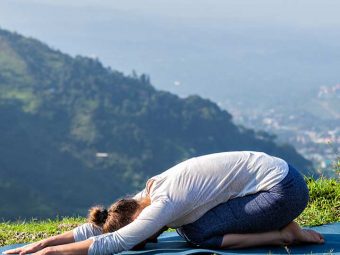7 Amazing Power Yoga Workouts (With Pictures)
Add power yoga poses to your exercise routine to strengthen your body and mind.

Image: Shutterstock
Power yoga workouts are strenuous. Power yoga, also called ‘gym yoga,’ is a modified version of classical yoga appropriate for today’s fast-paced world.
Power yoga makes you sweat a lot. It is invigorating, pounding, and comforting all at once. It incorporates the best elements of yoga with the advantages of a modern workout.
It is the best of both worlds, in our opinion. So, to put it bluntly, power yoga is mind-blowing and life-changing; you must experience it for yourself to get what we are saying.
In this post, we will show you how to get started with power yoga routines. Let’s take a look at how power yoga came to be before we get started. Continue reading to know more about power yoga, its benefits, and more.
In This Article
What Is Power Yoga?
Power yoga is a term that came to be in the 1990s. It is a western concept that is a variation of Ashtanga yoga. The practice is rigorous and accelerates your heart rate.
Power yoga involves synchronized fast-paced movements with breath control. It is a high intensity workout uniting the mind and the body.
It increases your stamina, tolerance, strength, flexibility, and stability. Poses in power yoga are done one by one without any gap at a speed that challenges your strength.
Power yoga now has various formats, but the original power yoga was developed and founded by Beryl Bender Birch. The core of the practice remains the same though. It is essentially a dynamic breath-based movement that has a certain flow in practice.
In power yoga, you move in and out of poses quickly lifting and holding your entire body weight while you are at it. Power yoga keeps you fit physically and mentally. Also, it keeps you aware of your spiritual side. It is a wonderful, advanced version of yoga to help you with calorie burn, weight loss, and stress relief.
According to a study undertaken to examine the relationship between stress levels caused by adverse events and the practice of yoga, at least 43.9% of 1568 racially diverse young adults have at least one childhood adverse event, and 40% reported having experienced discrimination. At least 12.7% of the population practiced yoga 30 mins/week to help manage stress.
Amy, a blogger, practices power yoga and shares her experience on her blog. In one of her posts, she observes, “My class was so great that I made my friends from work go to a beginner class later that week. Even though I think the 3 of us could have handled a C2 class, it was great to go to a C1 class and learn the basics. C2 is still my favorite so far (i).”
Check the power yoga poses below to find out what it is all about.
Power Yoga Workouts
Power yoga is old wine in a new bottle that gained a quick pace in the world of health and fitness in the last two decades. While it is still in the framework of traditional yoga, there is a variation in the manner of practice.
It is quick and moves on to the next pose in a flow without any gap or rest. The effort is forceful and vigorous.
Try the power yoga style with the following poses.
- Ardha Chandrasana (Half Moon Pose)
- Paripurna Navasana (Boat Pose)
- Ustrasana (Camel Pose)
- Salabhasana (Locust Pose)
- Chaturanga Dandasana (Plank Pose)
- Adho Mukha Svanasana (Downward Facing Dog Pose)
- Utkatasana (Chair Pose)
1. Ardha Chandrasana (Half Moon Pose)
About The Pose—Ardha Chandrasana or the Half Moon Pose looks like a half moon and is hence named so. It is a beginner level Hatha yoga asana. Practice it in the morning on an empty stomach or evening after a gap of 4 to 6 hours from your last meal and hold it for 15 to 30 seconds.
Benefits—Ardha Chandrasana strengthens your legs, buttocks, and spine. It stretches your hamstrings and opens your hips. Ardha Chandrasana builds coordination and balance.
To know more about the pose and its procedure, click here—Ardha Chandrasana.
2. Paripurna Navasana (Boat Pose)
About The Pose—Paripurna Navasana or the boat pose forms a ‘V’ shape similar to that of a boat. It is an intermediate level Ashtanga yoga asana. Practice it in the morning or evening on an empty stomach and clean bowels. Hold the pose for 10 to 60 seconds.
Benefits—Paripurna Navasana strengthens your abdomen and improves your digestion. It stimulates your thyroid and intestines. The asana improves your confidence and relieves stress.
To know more about the pose and its procedure, click here—Paripurna Navasana.
3. Ustrasana (Camel Pose)
About The Pose—Ustrasana or the Camel Pose is a backbend that resembles the stance of a camel. It works best when practiced in the morning on an empty stomach and clean bowels. Ustrasana is a beginner level Vinyasa yoga asana. Hold the pose for 30 to 60 seconds.
Benefits—Ustrasana strengthens your back and shoulders. It improves your posture and respiration. It relieves lower backache and strengthens your thighs. The asana works well for your overall well-being.
4. Salabhasana (Locust Pose)
About The Pose—Salabhasana or the Locust pose is a back bend that looks like a grasshopper. Practice it in the morning on an empty stomach or evening after a gap of 4 to 6 hours from your last meal. Salabhasana is a beginner level yoga asana. Hold it for 30 to 60 seconds.
Benefits—Salabhasana strengthens the muscles of your upper and lower back. The pose relieves anxiety and calms your brain. It strengthens your arms and increases the endurance of your body.
 Did You Know?
Did You Know?5. Chaturanga Dandasana (Plank Pose)

About The Pose—Chaturanga Dandasana or the Plank Pose is an asana that is similar to a plank. Chaturanga means four-limbed as the asana requires the support of your four limbs. Practice it in the morning on an empty stomach. It is a beginner level Vinyasa yoga asana. Hold it for 30 to 60 seconds.
Benefits—Chaturanga Dandasana increases your core strength. It invigorates your mind and body. The pose increases your stamina by strengthening your arms, legs, and wrists.
To know more about the pose and its procedure, click here—Chaturanga Dandasana.
6. Adho Mukha Svanasana (Downward Facing Dog Pose)
About The Pose—Adho Mukha Svanasana or the Downward Facing Dog is an asana that resembles the stance of a dog when it bends forward. Practice it in the morning on an empty stomach and with clean bowels. It is a beginner level Ashtanga yoga asana. Hold it for 1 to 3 minutes.
Benefits—Adho Mukha Svanasana energizes and rejuvenates you. It increases your lung capacity and relieves mild depression. The pose strengthens your bones preventing osteoporosis.
To know more about the pose and its procedure, click here—Adho Mukha Svanasana.
7. Utkatasana (Chair Pose)
About The Pose—Utkatasana or the chair pose is an asana where it feels like you are sitting on an imaginary chair. It is not as easy as sitting on an actual chair though. Practice the asana in the morning on an empty stomach. It is a beginner level Vinyasa yoga asana. Hold it for 30 to 60 seconds.
Benefits—Utkatasana increases your determination and tones your knee muscles. It strengthens your ankles, calves and hip flexors. The pose stretches your chest and stimulates your heart.
 Did You Know?
Did You Know?You can incorporate the different power yoga poses mentioned above into your workout routine to reap the benefits. But how does it improve your overall health? Scroll down to find out.
Benefits Of Power Yoga
- Power yoga provides the following health benefits (1), (2):
- It focuses on building muscular strength through a series of challenging poses and movements that help sculpt the entire body.
- It improves flexibility by stretching and enhancing your range of motion..
- It is a vigorous workout that helps burn calories and may support weight loss goals.
- The mindful breathing and concentration in power yoga promote relaxation, reduce stress, and improve mental clarity.
- It includes fast-paced sequences that elevate the heart rate, improving cardiovascular fitness.
- It improves balance, posture, and coordination.
To know more about the pose and its procedure, click here—Utkatasana.
Infographic: 5 Power Yoga Poses You Should Try At Home
Power yoga is a variation of Ashtanga yoga and involves a range of fast synchronized movements with controlled breathing. While it originated in the West, today, it is recognized worldwide as an energizing activity. Check out the infographic below to learn about six popular power yoga poses you can include in your workout routine.

Illustration: StyleCraze Design Team
Power yoga workouts are a modernized version of traditional yoga that caters to today’s fast-paced lifestyle. They combine the best aspects of yoga with the benefits of a modern workout that brings the mind and body together. The exercise is strenuous and raises your heart rate. Power yoga can be your go-to activity if you want rapid and vigorous motions and need to sweat it out to feel like you have worked out. A single session of power yoga can have noticeable relaxation and rejuvenation effects. It blends the best of styles to provide you with a complete workout. Go for it!
Frequently Asked Questions
At what age can one begin practicing power yoga?
Children above 12 years can start learning and practicing power yoga because before that their core muscles are yet to develop.
How often do I practice power yoga?
You can practice power yoga every day or at least 2 to 3 days a week if it gets too strenuous to do it daily. Pair it with meditation for improved physical and mental well-being.
Is power yoga suitable for everybody?
Practicing power yoga is advised for physically fit people who willingly exercise.
What are the most important safety precautions for power yoga?
Avoid power yoga or consult a professional if you are pregnant, or have a chronic condition, or are suffering from serious injuries, or if you are recovering from a recent surgery.
What are some common mistakes to avoid when doing power yoga?
Power yoga is not like traditional yoga for mindfulness, but rather a high-intensity workout. The common mistakes to avoid include wrong breathing techniques, going beyond the body’s limit, skipping warm-ups, and not relaxing the muscles.
What is the difference between power yoga and regular yoga?
Power yoga emphasizes the flow from one pose to the next by exhaling as one changes positions. Regular yoga focuses less on the flow of poses and more on achieving the right posture.
What are the cardiovascular benefits of power yoga?
Power yoga strengthens the heart and lungs, controls weight, high blood pressure, and blood sugar levels, improves cholesterol levels, sleep and brain functions, and lowers the risk of heart disease, stroke, and diabetes.
Are there any specific warm-up exercises should we do before doing power yoga?
Warm-up exercises include fast-paced walking, jogging on the spot, arm swings, lunges, and squats.
What type of clothing should we wear for power yoga?
Any type of clothing can be worn for power yoga as long as the fabric is breathable and flexible, like a narrow- or form-fitting top, yoga pants or shorts, and a sports bra or built-in shelf bra.
If you are one of those, who likes quick and forceful movements and needs to sweat it out to feel like you worked out then power yoga is your go-to activity. It combines the best of styles and offers you a holistic exercise experience. Try it and let us know how it was.
Key Takeaways
- Power yoga is a high-level yoga that improves your strength, stability, stamina, and tolerance.
- Ardha Chandrasana boosts coordination and balance. Paripurna Navasana improves digestion and strengthens the abdomen. Ustrasana improves your overall health and wellness.
- Other power yoga poses are Salabhasana, Chaturanga Dandasana, Adho Mukha Svanasana, and Utkatasana
Get ready to tone your abs and butt with this 30-minute power yoga session. Click on the video below to get your body in shape with this quick and effective workout.
Personal Experience: Source
StyleCraze's articles are interwoven with authentic personal narratives that provide depth and resonance to our content. Below are the sources of the personal accounts referenced in this article.
(i). My Amazing Yoga Experience – CorePower Yoga Walnut Creek Reviewhttps://fitnessmeetsfrosting.wordpress.com/2015/04/13/my-amazing-yoga-experience-corepower-yoga-walnut-creek-review/
References
Articles on StyleCraze are backed by verified information from peer-reviewed and academic research papers, reputed organizations, research institutions, and medical associations to ensure accuracy and relevance. Read our editorial policy to learn more.
- A comparison of the acute effects of different forms of yoga on physiological and psychological stress: a pilot study
https://www.ncbi.nlm.nih.gov/pmc/articles/PMC7503485/ - Effect of power yoga and pranayama practices on selected physical and physiological variables among intercollegiate sports men
https://www.allresearchjournal.com/archives/2020/vol6issue8/PartC/6-8-10-885.pdf






